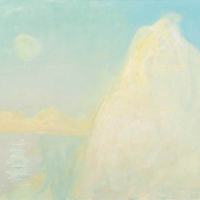63. LLOYD REES

Lloyd Rees is known as one of the great interpreters of the Australian landscape. He has alternated between light and dark moods throughout his artistic career; with earlier European-inspired works favouring lead as a medium, to his later works where titanium white was used freely, culminating in the mood of sunshine of the 1980s.1 His preoccupation with depicting the effect of light resulted in a body of work which conveys the serenity of the Australian landscape as he sought to express an ideal of harmony between man and nature.
Born in Brisbane in 1895, of Welsh and French descent, Rees later moved to Sydney and was employed as a commercial artist. He developed a drawing style which resulted in many pencil drawings of Sydney Harbour, or pencil-paintings as they came to be known. His painting technique developed from tonal Corot-esque paintings in the 1920s and 1930s. Rees visit to Europe in the 1950s left a lasting impression on him and his art; the influence of the French countryside and the sweeping Tuscan landscape left imprints on his painting once he returned to Australia. This influence is evident in the artists two series of paintings, The Timeless Land and Australian Facade where the landscape is treated with the grandeur of ancient European sites.
Rees series, Song to Creation, painted for his retrospective exhibition at the Art Gallery of New South Wales in 1969, reveals his obsession with painting light which became the major subject of his work for the next two decades. The artist had gained confidence to paint the sun itself; his landscapes were becoming opalescent, colour was translucent as it washed over the ever-larger canvases he began using. Renee Free describes the softer hand and palette which became Rees new style in the 1980s- In this decade...the paintings have become paler, elemental, transcendental, but always held to landscape by an initial sensation in the landscape itself...the artist has always preferred landscape that has signs of habitation; boats, houses - but now there are remote uninhabited hills and mountains. There is a greater sense of the artist solitary and stillness, the beginning of the endless journey.2
Afterglow (Sunset & Moonrise) 1987 is an excellent example of this shift in style adopted by Rees later in life, which focused on the play of light on the Australian landscape. The muted colours and soft contours of the horizon and foreground are characteristics of the phase of Rees art, a time in his life when old age and failing eyesight hindered the creation of his art. In 1985, Rees moved from his Sydney home to Hobart due to illness, where he lived with his son, Alan, and daughter-in-law. The house was situated high above the Derwent River and its many windows commanded magnificent views of the surrounding river and mountains. Rees found a subject through nearly every window and also painted the coastal and mountain areas in the south. In the same year the Afterglow (Sunset & Moonrise) 1987 was painted, Rees was awarded the Jack Manton prize by the Queensland Art Gallery for his work The Sunlit Tower. The artist was ninety-one years old.
Afterglow (Sunset & Moonrise) 1987 is a rare work from a period of Rees life where art has triumphed over self-doubt, personal adversity and the inevitable limitations of old age. With the support of his family and his undiminished passion for painting, he was able to create some of his most successful works. Hendrik Kolenberg, the Curator of Art at the Tasmanian Museum and Art Gallery during this time, described this group of Rees paintings as perhaps more emotionally charged than previously, they are particulary poignant and expressive.3
Footnotes:
1. Free, R., Lloyd Rees: An Artist Remembers, Craftsman House, Sydney, 1989, p.9
2. Ibid
3. Kolenberg, H., quoted in the introduction to Lloyd Rees, the Tasmanian Suite, exhibition catalogue, Boython-Meadmore Gallery, Sydney, July 1987
Caroline Jones BA, MArt Admin.